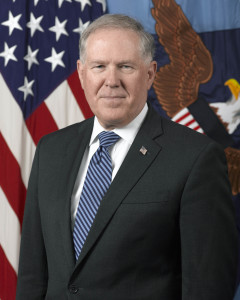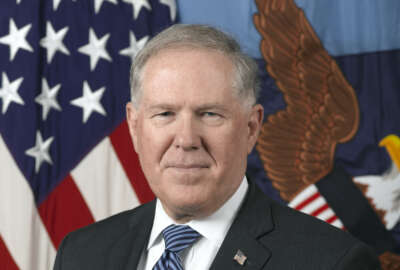
DoD treads lightly with new rule on public R&D funds
DoD released a proposed rule that will require companies to give the Pentagon more information about IR&D projects.
New details have emerged on how the Defense Department intends to crack down on the possible abuse of independent research and development bid and proposal costs.
DoD is proposing a rule that would require new IR&D efforts by industry be communicated to appropriate DoD personnel prior to the initiation of the investments. The rule would also require the results of the investment be shared with DoD personnel.

“The objective of this engagement is to ensure that both IR&D performers and their potential DoD customers have sufficient awareness of each other’s efforts and to provide industry with some feedback on the relevance of proposed and completed IR&D work,” the Feb. 16 proposed rule states.
The notice in the Federal Register stated the intent of the rule is not to reduce the independence of IR&D investment selection nor establishing a bureaucratic requirement for government approval prior to initiating a project.
Frank Kendall, DoD’s undersecretary for acquisition, technology and logistics told industry he was looking for more information on IR&D back in September.
“What I am looking for … is that there is some meaningful technical content in the award that’s been put out, that’s really the fundamental point,” Kendall said. “By requiring industry to tell government what it’s doing will encourage more meaningful content.”
DoD requested about $75 billion for research and development for fiscal 2016 — that’s about 12 percent of the entire defense budget.
A Feb. 8 notice in the Federal Register is convening an industry day in March to discuss the rule change.
Currently, the Pentagon funds defense companies for the research and development they do since some of the products those companies create only have one consumer, the government. At times, those products never translate into products that can be put on the market for private consumption.
In other cases companies have been accused of beefing up IR&D funding in contracts to lower their bid price for a contract with DoD.
DoD’s Better Buying Power 3.0 reforms laid out an interest in cracking down on industry’s use of public funds for near-term goals, like reducing the price on a competitive item, and not to actually create intellectual property. The Pentagon said there was a disconnect between what the government was expecting and what industry was providing. As a result, DoD required reviews to ensure it was aware of industry’s goals and plans for a project before funding it.
The announcement caused a tizzy in the defense industry, which led to DoD releasing a white paper in August to allay companies’ fears over stricter rules.
The paper assured industry that DoD was not trying to strong-arm industry, but rather ensure a two-way dialogue that would provide for some minimum oversight.
Some experts think industry takes advantage of DoD’s subsidies to companies for IR&D.
“It seems to me that what [is spent out of IR&D funding] in the name of research … is relatively small,” Subrata Ghoshroy, a former senior defense analyst at the Government Accountability Agency, told Federal News Radio. “The science and technology is an area in my opinion where actual scientific research takes place. The rest of the budget is not really doing that much research … it is any area where the corporations tend to make a lot more money by building prototypes and often they don’t go anywhere.”
In a 2011 article in the Bulletin of Atomic Scientists, Ghoshroy writes, “Congressional military committees have for years grossly abused the Defense R&D budget, using it to channel money to contractors in their districts via the earmarking process.”
IR&D funds make up a large part of the R&D investments for private defense companies.
Wesley Bush, CEO of Northrop Grumman, said his company spent about 4 percent of its revenue on R&D that was not publicly funded in 2014.
That trend stays steady for most defense companies. Boeing spent a little over $3 billion in 2014 for R&D, about 3 percent of its total revenue, according to a report by AeroWeb, an aerospace and defense market company.
Similarly, Raytheon spent $500 million in 2014, only 2 percent of its total revenues.
A report by the Information Technology and Innovation Foundation found that R&D spending as a share of sales by defense contractors declined by nearly one-third between 1999 and 2012.
Non-government technology companies, by comparison, spend billions more and at a much higher percentage of their revenues on R&D. Apple spent $2 billion on R&D in the first quarter alone of 2015. Samsung spent $13.4 billion in 2014 on R&D and Microsoft spent $10.4 billion.
Gwynne Shotwell, president and COO of SpaceX, said defense industry R&D spending is “incredibly low” and that a huge part of the reason defense companies have an innovation problem is because of the low funding.
Defense companies, however, say that the marketplace is different from the commercial marketplace.
“The investments required are very large and they are very long-term before you get a return,” Kendall said. “We buy in many cases very specialized, very complicated, very expensive products that take a long time to develop and we buy them in an environment in which the assurance that there’s going to be sales is kind of limited.”
Bush said private R&D is a very limited view of what defense companies do. He said Northrop Grumman’s scientists usually have no idea if the project they are working on will translate to the marketplace.
Bush said his company is making investments in products it will not commercialize and the moment it is commercialized it begins to “wash away” technological superiority.
That, however, does not take into account if companies later release technologies commercially once the technology gap has been closed by adversaries.
Copyright © 2024 Federal News Network. All rights reserved. This website is not intended for users located within the European Economic Area.
Scott Maucione is a defense reporter for Federal News Network and reports on human capital, workforce and the Defense Department at-large.
Follow @smaucioneWFED





